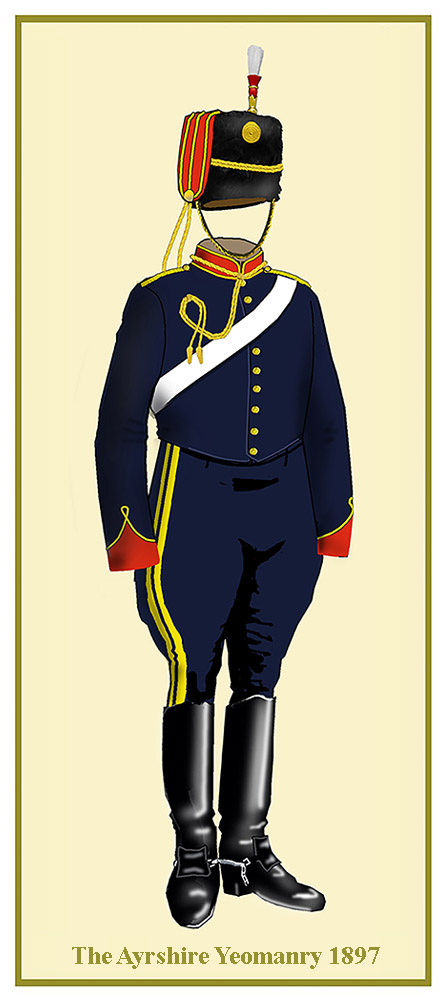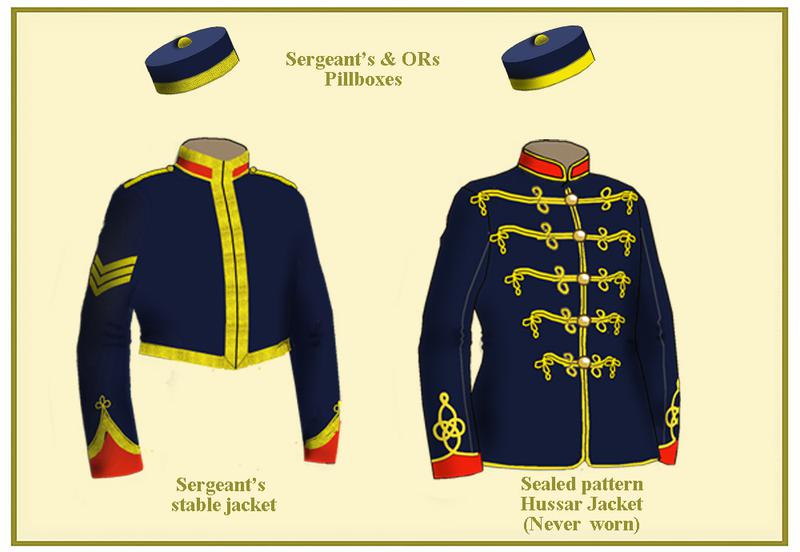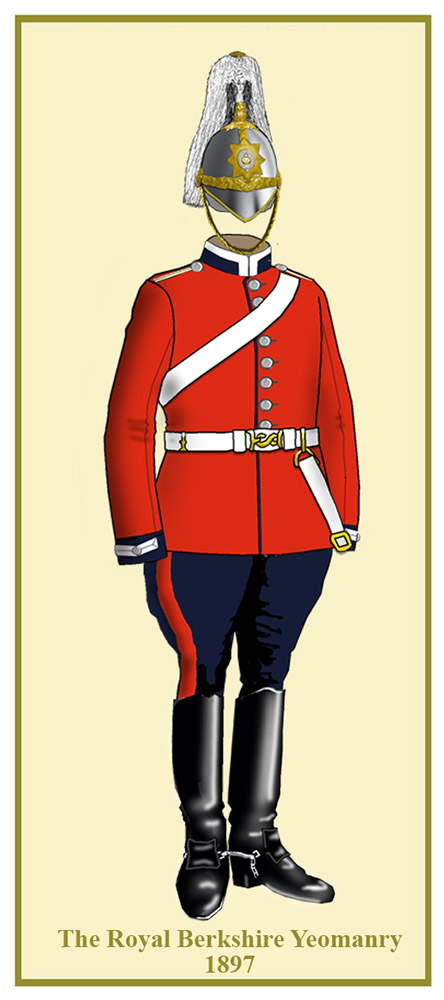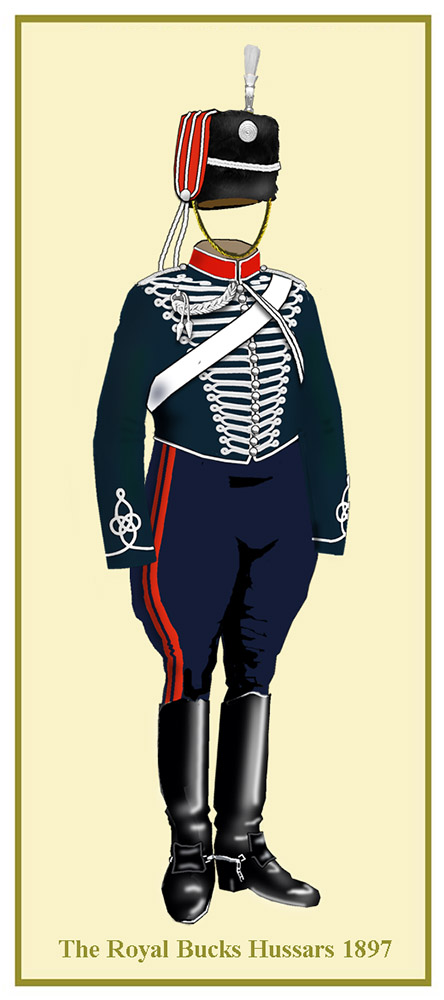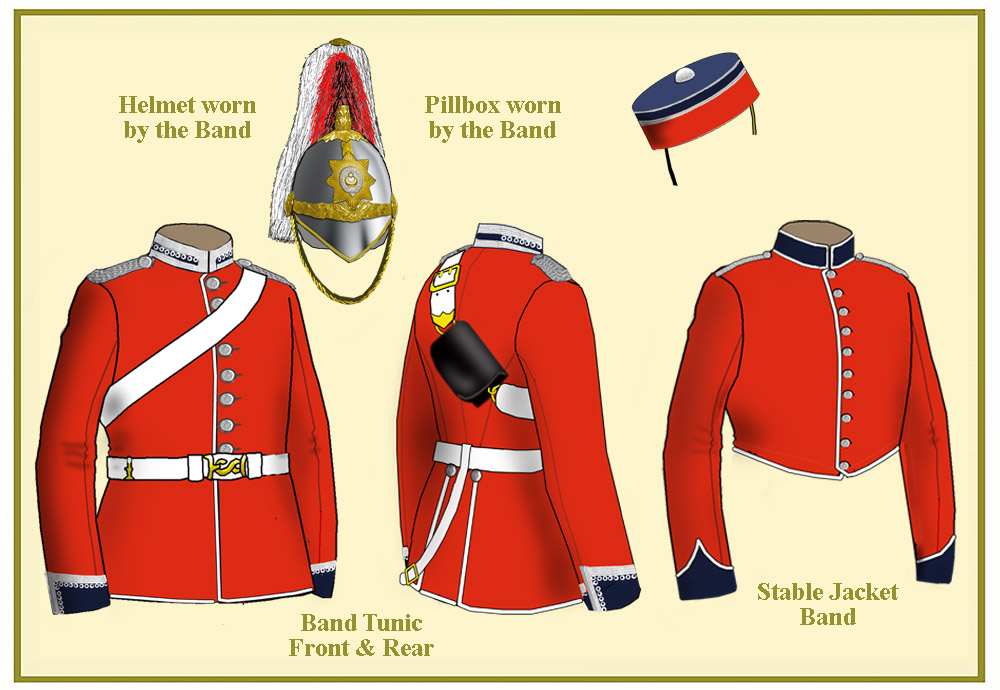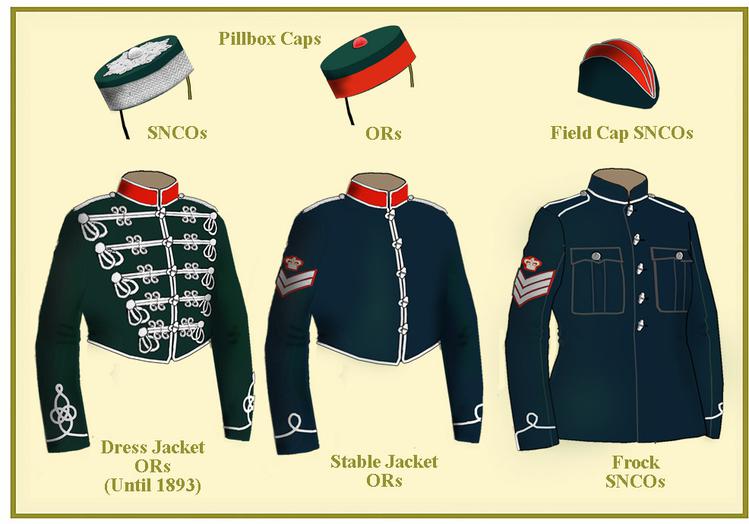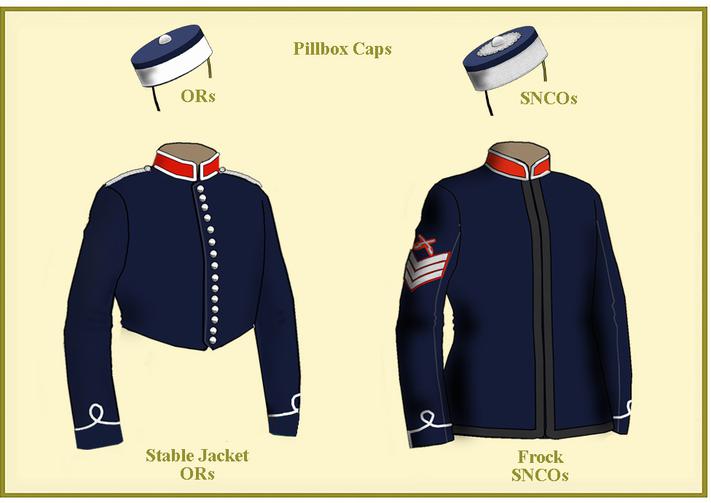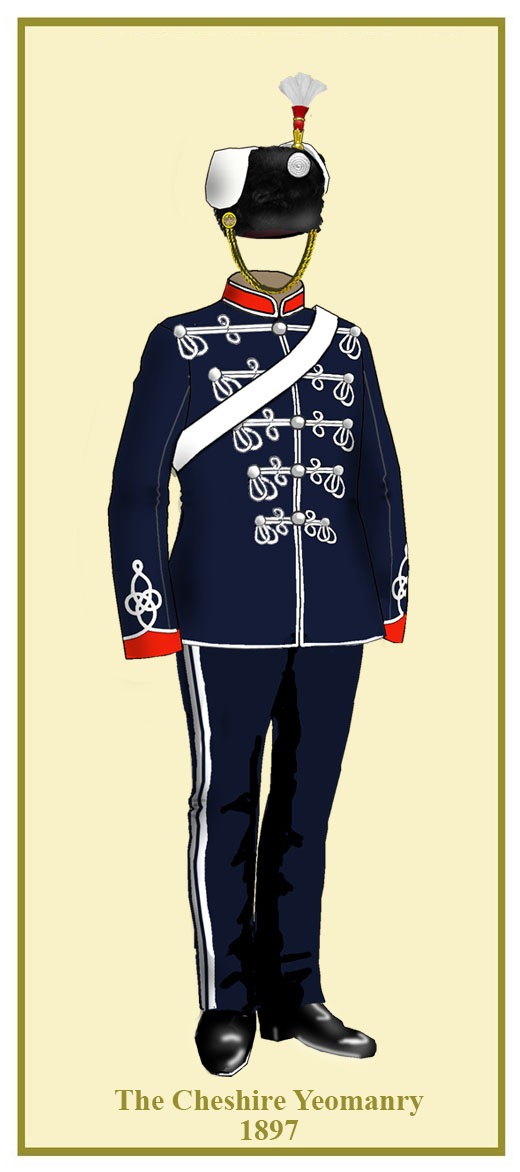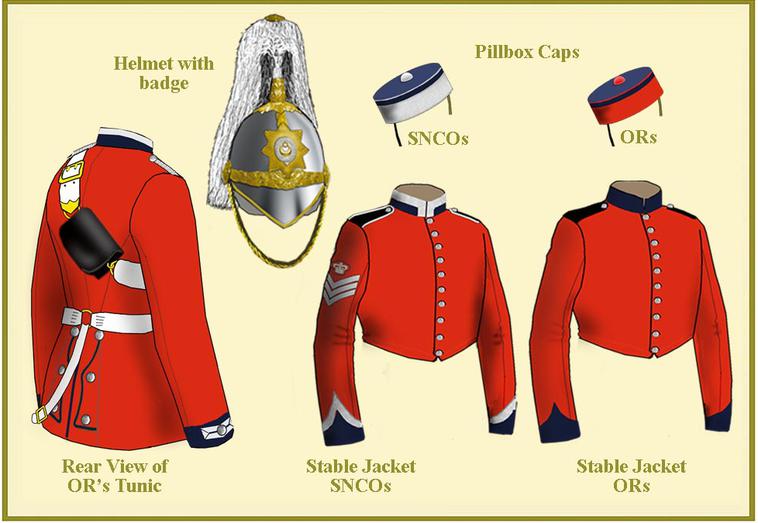The Ayrshire Yeomanry (Earl of Carrick's Own)
Ranked No. 7 in Yeomanry Order of preference
Formed c.1794 as an independent troop of Fencible Cavalry and formally accepted as the Ayrshire Regiment of Yeomanry Cavalry in 1798. Existed as two regiments from 1817 until 1827. In 1897, the Regiment was granted permission to use the title Ayrshire Yeomanry Cavalry (Earl of Carrick's Own) in honour of the future King Edward VII.
Formed 17th coy of 6th Bn Imperial Yeomanry in 1900 (with Lanarkshire Yeomanry)
UNIFORMS OF THE BRITISH YEOMANRY REGIMENTS 1895-1900
Uniform
From the beginning they were conventionally dressed as Light dragoons with blue jackets faced yellow. In 1858 a contemporary hussar tunic with three loops of gold lace and scarlet facings was adopty officers and blue trousers replaced the grey ones previously worn. A black japanned helmet with black plume was taken into wear at the same time. The plume on the helmet was discontinued in 1875 and an infantry style blue cloth helmet replaced it in 1879. It appears to have had a star plate, but no badge is mentioned. Most evidence shows that the stable jacket remained the principle garment worn by other ranks. When busbies with scarlet bags replaced the helmets in 1893, the men still paraded with stable jackets. These were blue with scarlet collars and cuffs piped yellow and a yellow loop on the cuff. Sergeants and above wore the same jacket with gold lace edging all around. Rank badges were of gold lace. Full hussar tunics were authorised for wear in 1897 but there is no evidence that they were ever worn by other ranks (A sealed pattern existed, but it may remain the only example). Officers wore it and it was distinguished by the curved gold looping across the chest, which was unique to the regiment. The Ayrshire Yeomanry were one of the few yeomanry regiments to retain gold lace.
After the Boer War the regiment went into khaki with slouch hats and received khaki peaked caps in 1908.
The Royal Berkshire Yeomanry
Ranked No. 26 in Yeomanry Order of preference
A Yeomanry troop was raised in Abington in 1794 followed by further troops in 1800 and 1804. Known as 1st Regt of Berkshire Cavalry in 1804. Eastern Berkshire Yeomanry in 1820. All troops disbanded in 1827. In 1831 Regiment was re-raised, growing to three troops only one of which, the Hungerford troop survived by 1838. By 1853 Title became Royal Berkshire Yeomanry.
Formed 39th coy of 10th Bn and 58th coy of the 15th Bn Imperial Yeomanry from 1900 to 1902
Uniform
The yeomanry units in Berkshire generally were dressed conventionally in blue from the beginning. When re-raised in 1831 they adopted scarlet coats (possibly because William IV had ordered all British cavalry into scarlet during his reign). A bell topped shako was worn until 1852 when a black japanned helmet with black plume was adopted. In 1858 scarlet tunics were taken into wear much in the style of the contemporary heavy cavalry tunic. Blue overalls were worn with a broad scarlet stripes. At the same time a white plume replaced the black one on the helmet. By 1880 a white metal 1874 Albert pattern helmet was adopted which had overtones of the old 1847 version with the leaf patterned socket plume holder and a strip of brass on the helmet seam both back and front. The tunic remained the same and although the cuffs retained the "V" shaped lace with button, the collar had a wide strip of white lace on the top and front of the collar. The rear skirts were decorated with scalloped flaps edged blue. Unlike the regular heavy cavalry, there were only two points to the scallops each with a button and two buttons at the waist.
Scarlet stable jackets were worn in undress and the pattern seems to have remained unchanged since the 1850s. The men's were plain with blue collar and pointed cuffs while sergeants and above had silver lace on collar and cuffs. Sergeants and above had a crown above their chevrons. The white shoulder cords were replaced by blue shoulder straps in 1898. Pillbox caps were blue with scarlet band and crown lace for other ranks all in silver for SNCOs.
In 1900 they went to war in khaki and the scarlet uniforms were put into store and in 1903 they were wearing khaki with scarlet collars and cuff piping with slouch hats. By 1908 they had adopted blue staff pattern caps with scarlet bands and blue serge frocks with scarlet collars and pointed cuffs and shoulder chains.
The assistance of Andrew French, assistant curator of the Berkshire Yeomanry Museum is much appreciated
The Royal Bucks Hussars
Ranked No. 21 in Yeomanry Order of preference
There were three yeomanry regiments in Buckinghamshire from 1794 to 1827. These were the 1st (Buckingham), the 2nd (Aylesbury) and 3rd (Mid-Buckingham) regiments. All save the 2nd were disbanded in 1828. In 1845 the regiment became "Royal" after escorting Queen Victoria on a visit. In 1889 They received the title Royal Buckingham Hussars Yeomanry
Formed 37th & 38th coys of 10th Bn Imperial Yeomanry in 1900
Uniform
Various shades of green distinguished the Buckingham corps from the beginning. They were designated as hussars in 1825 and the surviving regiment wore a mid green hussar jacket with grey overalls and black shako from the 1830s. The regiment replaced the heavy lace on the front of their dark green jackets with five loops of white hussar frogging in 1858. The collar and cuffs were black. They also took into wear a low crowned shako with white band around the top and a white drooping plume. In 1873 they were issued with the contemporary hussar busby with a white over red plume and red bag. Red replaced the black on the jacket collars and the cuffs became plain and the overalls changed to dark green with single red stripe at the same time. In 1892 the uniform changed again when the jacket was replaced with a version in "invisible green" a shade that was virtually dark blue with a hint of green in certain lights. The lacing in white was of RHA style. At the same time the overalls were replaced with dark blue pantaloons with double scarlet stripes. Overalls were only worn for dismounted duties. The busby plume became all white and the caplines went round the body and up to the top button where it was plaited, 11th Hussars style, and looped across the chest. For a time, NCOs wore the old green 1858 style jacket as a stable jacket but soon took up a plainer version with silver lace. The other ranks were the same with white lace. All NCOs wore a crown above their chevrons. An invisible green frock was introduced for NCOs in 1899. This had white piping on the lower collar, shoulder straps and cuffs. Pill boxes remained the same as in the 1860s. They were green with red band and button for ORs and with silver band, button and top decoration for SNCOs. A filed cap in Austrian style was adopted in the late 1890s. This had a scarlet body, invisible green flaps and silver piping for SNCOs and none for ORs.
After the Boer War, the Bucks Hussars took up slouch hats and khaki frocks with red collars. After 1908 they wore the invisible green frock, with shoulder chains and no piping for undress. At the coronation of King George V they wore the old full dress uniform with overalls to line the route.
The assistance of Ian Beckett of the Buckinghamshire Military Museum's Trust with this article is much appreciated.
The Cheshire Yeomanry (Earl of Chester's Own)
Ranked No. 8 in Yeomanry Order of preference
Raised in Macclesfield as a troop of yeomanry in 1797 as a response to the threat of invasion from France. In 1803 regimented as the Western Cheshire Volunteer Cavalry and was awarded the title of Prince Regent’s Regt. Of Cheshire Yeomanry in 1814. Became famous for its involvement in the Peterloo Massacre of 16 August 1819. A lancer troop in Adlington existed from 1820 to 1838. In 1849 title was changed to The Earl of Chester’s Yeomanry in honour of the Prince of Wales (future King Edward VII).
Formed 21st & 22nd coy of 2nd Bn Imperial Yeomanry in 1900
Uniform
Conventional blue light dragoon uniforms were originally worn with the crested Tarleton Helmet with red turban. They were permitted to use the Prince of Wales's badge of three feathers & coronet in 1820 which they retain today. Hussar styles were taken into use in the early 1820s including a richly decorated black felt shako.
The badge was a Maltese Cross with the prince of Wales plumes in the middle. In 1845 an Albert pattern shako was introduced with a black cock's feather plume for officers and in horsehair for men. In the late eighteen fifties a conventional hussar uniform was taken into wear with white lace frogging. The Albert pattern shako was replaced with the tall busby in 1863. This had a red bag with white over red plume. There was little change until the late 1880s when an unusual pattern of hussar busby was adopted. This was modelled on the German version taken into use after the Franco-Prussian War. It was shorter than the British pattern with a white small bag on the right (the opposite side to the standard German one). The chin chain bosses were on the outside and the short cap lines were worn around the busby but not hanging down to the neck and looped around the body. There was no busby bag lace and the upper plume was sprayed. Stable jackets were fairly plain with red collar and plain cuffs with white piping. SNCOs wore an interesting undress frock with scarlet collar white piping on collar and cuffs and there was black lace edging front and lower skirts.
After the Boer War the regiment, like all Yeomanry, went into khaki. The 'German' hussar busbies were never taken back into use. In 1908 they wore the regular hussar full dress with staff pattern caps. At the funeral of King George V in 1911, they apparently borrowed busbies from the 19th Hussars!
PART 1
Berkshire Yeomanry Mounted Band
The Hungerford troop had a band as early as 1842 and had received kettledrums in 1853.
From about 1879 the band had adopted a distinctive uniform based somewhat on that of the Household Cavalry. The tunic was edged all round with silver lace and there was half-inch silver lace on the top, and bottom of the collar and on the top and rear edge of the gauntlet cuffs. On the collar and cuff lace there were small 'eyes' traced below. the rear skirts had two single straight lines of lace from the buttons. The plaited shoulder cords were also silver.
The helmet was the same as the rest of the regiment except that it had a white over red plume.
The band stable jacket had silver edging to the front and lower edges and on the collar and cuffs. There were shoulder cords instead of straps. The pillbox cap had a silver edging to the crown and top of the red band.
The Ayrshire Yeomanry
The Royal Berkshire Yeomanry
The Royal Bucks Hussars
The Earl of Chester's Yeomanry
